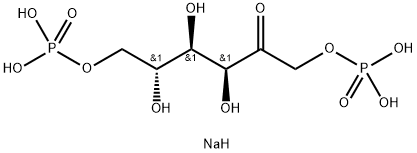|
|
| Product Name: | D-Fructose 1,6-bisphosphate trisodium salt | | Synonyms: | FDP-Na3H;D(+)FRUCTOFURANOSE 1,6-DIPHOSPHATE TRISODIUM SALT;D-FruCLose 1,6-bisphosphate trisodiuM salt;D-Fructose 1,6-bisphosphate hydrate trisodium salt;Harden-Young ester, Hexose diphosphate hydrate trisodium salt, D(+)Fructofuranose 1,6-diphosphate hydrate trisodium salt;D-Fructose-1,6-biphosphate trisodium salt octahydrate;HEXOSE DIPHOSPHATE TRISODIUM SALT;HEXOSE DIPHOSPHATE | | CAS: | 38099-82-0 | | MF: | C6H15NaO12P2 | | MW: | 364.11 | | EINECS: | 253-778-0 | | Product Categories: | Dextrins、Sugar & Carbohydrates | | Mol File: | 38099-82-0.mol |  |
| | D-Fructose 1,6-bisphosphate trisodium salt Chemical Properties |
| | D-Fructose 1,6-bisphosphate trisodium salt Usage And Synthesis |
| Biochem/physiol Actions | Fructose-1,6-biphosphate (F1,6P) is a glycolytic intermediate produced by the transfer of a phosphate from ATP to fructose-6-phosphate by the enzyme phosphofructokinase. Fructose-1,6-biphosphate, along with fructose-2,6-biphosphate, modulates the activity of phosphofructokinase-1 (PFK-1), the rate-limiting step in glycolysis. During glycolysis, aldolase splits Fructose-1,6-biphosphate into dihydroxacetone phosphate (DHAP) and glyceraldehyde phosphate. Fructose-1,6-biphosphate is also an allosteric activator of the M2 isoform of Pyruvate Kinase (PK-M2), the predominant form of pyruvate kinase in cancer cells. | | Uses | D-Fructose-1,6-bisphosphate trisodium salt is used to reduce ischemia-reperfusion injury in rats. | | Application | D-Fructose-1,6-bisphosphate (FBP), a common metabolic sugar, is the precursor of glyceraldehyde 3-phosphate and dihydroxyacetone phosphate in the glycolytic pathway. It may be used as an allosteric activator of enzymes such as pyruvate kinase and NAD+-dependent L-(+)-lactate dehydrogenase, as an inhibitor of acetate kinase and as a substrate to identify and characterize enzymes such as fructose-1,6-bisphosphate aldolase(s) and fructose-1,6-bisphosphatase(s). FBP is studied as a neuroprotective agent in brain injury. | | Purification Methods | Fructose-1,6-diphosphate is best purified via the acid strychnine salt which is stable for several months. To remove the strychnine, dissolve 5g in H2O (150mL), and add 5N NaOH (or KOH to obtain the K salt) to pH 8.3 (phenolphthalein) with vigorous stirring. Remove the precipitate by centrifugation, wash with cold H2O (2x 25mL), extract with CHCl3 until the extract is free of strychnine (ca 8 to 10times, Mandelein spot test). Freeze-dry the aqueous solution to give the Na salt which is hygroscopic. It has been recrystallised from aqueous EtOH as the octahydrate, m 125o, [] D +2.6o (c 1, H2O). A neutral solution of the salt keeps well in a frozen state for over several months. [Neuberg et al. Arch Biochem 3 33 1943, Sable Biochemical Preparations 2 52 1952, Stumpf J Biol Chem 182 261 1950]. The calcium salt can be partially purified by dissolving in ice-cold N HCl (1g per 10mL) and re-precipitating by dropwise addition of 2N NaOH: the precipitate and supernatant are heated on a boiling water bath for a short time, then filtered, and the precipitate is washed with hot water. The magnesium salt can be precipitated from a cold aqueous solution by adding four volumes of EtOH. The tetramethyl ester is an oil with n D 1.4648, [] 18 +20.2 (c 0.4, MeOH). [Schulbach & Rauchenberger Chem Ber 60 1178 1927, Beilstein 1 IV 4424.] |
| | D-Fructose 1,6-bisphosphate trisodium salt Preparation Products And Raw materials |
|